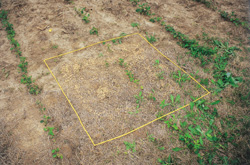
Features
Agronomy
Corn
Physiology and soybean potential
The soybeans scattered in this metre square are at a density that represents 110bu/ac.
November 12, 2007 By Top Crop Manager
There is much a grower can do to bring a field of soybeans towards its maximum
achievable yield. And even this practical yield level is well below the theoretical
physiological yield potential of the crop.
Figure 1. Relationship between protein and yield (three year average,
3100CHU area). Source: Ontario Oil and Protein Seed Crop Committee.

"It is the relationship between soybean physiology and yield that drives
the interest of agronomists, scientists and producers," says Dr. Gary Ablett
who is a soybean plant breeder and chair of the Department of Plant Agriculture
at the University of Guelph. "The resultant yield of soybeans is the product
of countless physiological processes (photosynthesis, nitrogen fixation, transpiration,
respiration and so on) and their interaction with both abiotic factors (temperature,
photoperiod, moisture) and biotic stresses (weeds, insects, diseases)."
In total, this represents an amazingly complex interaction of components. "In
reality though, it can be distilled into inputs and outputs. The output we are
most interested in, of course, is yield and seed yield," he adds.
Two of the principal elements that comprise the soybean seed are carbon and
nitrogen. Carbon compounds are the product of photosynthesis and nitrogen compounds
are generated by both nitrogen fixation from the atmosphere and nitrogen accumulated
from the soil.
"You can increase the total seasonal amount of carbon fixed through photosynthesis
by increasing the rate of photosynthesis per leaf or by increasing the amount
of total light intercepted. Recent studies have shown that although there are
some genetic differences for the rate of photosynthesis, they are not very large
and are considered insignificant. In addition, increasing photosynthetic rate
through crop models has also shown only very small gains. This just doesn't
seem to be a very fruitful avenue of research at this time," says Ablett.
"The other option, then, is to increase the total amount of light intercepted
throughout the growing season." Ablett uses established yield equations
that estimate realistic yield potential of soybeans is 110bu/ac.
A yield as large as 100bu/ac would require something in the region of 600lb/ac
of nitrogen to grow, given perfect conditions. "Clearly this represents
a significant challenge: to accumulate that much nitrogen to support maximum
yield levels. US soybean researcher, Tom Sinclair points out that both carbon
and nitrogen have to be considered together, not independently, when considering
physiological process to maximize yields," says Ablett.

Management strategies that support this concept include earlier planting dates,
full season varieties, narrow rows, higher seeding rates and a well nodulated
crop. All of these are well proven in Ontario growing regions and Ablett suggests
these apply in Manitoba as well.
Specific varieties bred for tofu typically contain 44 to 47 percent protein
and a seed mass of 23g/100 to 25g/100 seeds when compared with standard soybeans
of 39 to 42 percent protein and a seed mass of 14g/100 to 19g/100 seeds. The
negative relationship between protein level and seed yield is well known. Using
data from the 'food grade soybean variety trials' conducted in Ontario by the
Ontario Oil and Protein Seed Crop Committee, this relationship is shown for
21 varieties tested in the 3100 heat unit area over a three year period (see
Figure 1).
In addition, the relationship between seed size and yield also shows that negative
trend, although there is some confounding with protein levels. The same relationship
can be said for the small-seeded natto types, where yield levels are typically
80 to 85 percent of standard soybeans. In this case, it is the small seed size
in itself that limits yield potential along with the drag from 'wild soybeans'
where the small-seeded trait typically comes from.
The other relationship that plays into food grade soybeans is the relationship
between protein, oil and temperature. There is a well known negative relationship
between oil and protein levels. As protein goes up, oil level goes down and
vice-versa. Temperature also influences this adhering to the general theme that
warm summers/fall promote high oil, and cool summers/fall promote high protein.
Northerly growing regions, like Ontario and western Canada and northern US
states, are also well suited to produce higher protein (greater N content) soybean.
Consequently, varieties are developed to take advantage of this and made available
in regions suited to the amount of heat and growing days.
Beyond that, growers can assess particular varieties based on their own experiences
and, especially in the case of food grade soybeans, whether they grow their
crops in an identity preserved contract.
The Bottom Line
As technology moves forward and new uses for soybeans continue to expand, soybean
breeders face exciting challenges to supply these new markets. Leo
Guilbeault, Belle River, Ontario.
The equation
Dr. Gary Ablett uses an equation developed by Tom Sinclair to illustrate
this point: Yield = HI (Harvest Index) x RUE (Radiation Use Efficiency)
x I (solar radiation intercepted). Sinclair is author of Soybeans: Improvement,
Production and Uses.
Harvest index is the portion of the total dry matter that is grain. This
is usually expressed as 'apparent harvest index' which is the percentage
of the total above-ground dry matter that is grain. The maximum value
of HI for a good crop of soybeans is 0.55.
Radiation use efficiency is the ratio of accumulated above-ground crop
mass to intercepted total solar radiation. This is expressed in grams
per mega joule (g/MJ) and the maximum value is about 1.1g/MJ. RUE is also
a product of leaf area index and only reaches a maximum as the leaf area
index (area of leaves per area of ground) reaches 2.5.
Light interception is simply the total solar radiation intercepted over
the growing season expressed in mega joules per m2. Again, the accepted
maximum is 1200MJ/m2.
"The equation can be solved," says Ablett, as: Yield = 0.55
x 1.1 x 1200g/m2. This is 726g/m2, or 7300kg/ha, the equivalent of 110bu/ac.